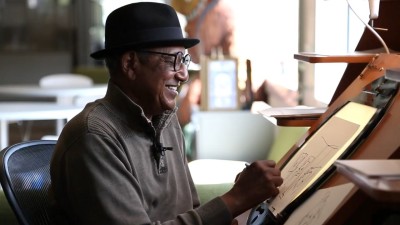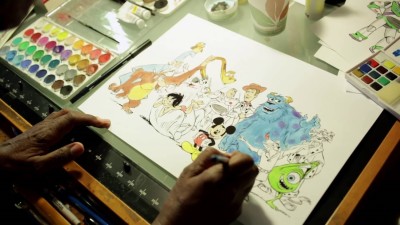Hired at Disney on February 6, 1956, Floyd Norman started his animation career as an “inbetweener” on none other than Disney’s beloved “Sleeping Beauty.” Assigned an animation sequence for the Prince and his horse Samson, Norman was given a few select images that would be part of the sequence being shot at 24 frames per second and then tasked to “fill in the animation blanks” with drawings that would carry out the motion within the frames. From the Prince and Samson, Norman moved onto the “inbetweens” for the fairies Flora, Fauna and Merryweather. And all the while, this young man was working under the tutelage of Disney’s famed “Nine Old Men” – the original Disney animators. Described as the animation on this film being the “equivalent of fine art”, Floyd and the rest of the animation team worked on “Sleeping Beauty” for five or six years, often being required to hand draw eight drawings per day. And thus began Floyd Norman’s animated life in animation.

Thanks to co-directors Michael Fiore and Erik Sharkey, with FLOYD NORMAN: AN ANIMATED LIFE, not only do we look inside the life of Floyd Norman, but the history and world of animation, and the early inner workings of Disney as we follow Norman’s journey. Once asked in an interview about how, as an African-American, he became interested in animation, an animated Norman replied, “Just as a kid growing up, I read comic books and I though I wanted to be a cartoonist. I never thought of the race issue.” For so many, the race issue is what set Floyd Norman apart from the world of animation. For Floyd Norman, he was oblivious to the issue or the distinction he holds as the first African-American employed by Disney. All that mattered was that he got to draw.
Lacing the documentary together with their own style of “inbetweens”, Fiore and Sharkey populate the film with interviews from animators, admirers and historians alike; from Don Hahn to Tom Sito and Leonard Maltin to Gary Trousdale, Dean DeBlois and Jane Baer to Whoopi Goldberg and Leo Sullivan, with each metaphorically serving as individual frames in a film strip or comic strip;

We learn Disney tidbits about the underground tunnels that ran from the Animation building to that of Ink & Paint so that drawings would never risk being rained upon or have the sun fade them just walking across the studio lot. And did you know that all of the employees in the Ink & paint Department were women; so hired because they had a “more delicate touch” for the purpose of painting? Surprising for many is the revelation that Roy Disney tried to talk brother Walt into dropping animation after “Sleeping Beauty”, with the animation department being slashed from about 500 artists to 75.
Anecdotes from Disney legend Richard Sherman on the making of “Mary Poppins” are not only telling of Walt Disney’s own creative process but lead us to yet another chapter in Floyd Norman’s journey as he was an assistant editor on the film charged with cleaning up the animation and creating the inbetweens; in this case regaling us with the challenges of “The Pearlies” and the individual pearls on their clothing with each done individually with pen and paper by hand. Animated in his own recollections, Norman’s fingers serve as drawing pencils and the air as his paper, as he draws and dots in the sky, taking us along on his trip down memory lane.

A long way from his childhood in Santa Barbara and his first drawing job doing the comic strip “Katy Keene”, we see Floyd Norman’s movement up the Disney ladder, including a short break during the Korean War following which he returned to his job at Disney and his “mentorship” under Milt Kahl on “The Sword in the Stone”, on to “Mary Poppins” and ultimately, when called to “The Jungle Book” by Walt Disney himself. Adding pop to the picture are animated caricatures and cartoons by today’s up and coming animators, paying homage to Norman’s history of obsessive drawing poking fun at his colleagues and the work process. Floyd Norman could never stop drawing.
But with the death of Walt Disney, Floyd Norman left Disney and together with several colleagues founded Vignette Films, a boutique company specializing in live-action and animated films about the African-American experience. Less than a success, on the demise of Vignette, Norman returned to Disney for a spell (leaving after an incident involving the new animated “Robin Hood”) before finding a new home at Hanna-Barbera as a writer/animator. The list of shows in which he was involved reads like a Who’s Who of cartoon classics.
But Disney was never far from Floyd Norman and he ultimately returned again to Disney Publishing, writing and illustrating Mickey Mouse comic books, as well as heading north to Pixar adding his expertise and storytelling skills to films like “Toy Story 2″, “Monsters, Inc.” and “the Tigger Movie.” Disappointingly, at age 65, Disney forced Norman’s retirement. However, even that didn’t stop Floyd Norman as he continued to go every day to the studio, including Disney Publishing where his wife Belle works, until Disney finally rehired him. With the DVD/Blu-ray release of “101 Dalmatians”, Norman was even asked to revisit his work on that film and complete a portion of the film that Walt Disney had cut. Digging out old layouts from Disney research archives, the excitement at watching Norman storyboarding by hand to pick up on work from decades ago is beyond joyously palpable.
The concurrently running historical timeline of the world, Disney and Floyd Norman is well constructed and supported thanks to a strong story narrative, while Norman’s upbeat outlook on life and animation is engaging and infectious. Peaks at some of Norman’s hand drawn “portraits” of famous Disney characters like “King Louie”, “Shere Khan” and “Mowgli” bring a smile to your face, especially when you see and hear other animators as excited as a kid on Christmas morning as they talk about a drawing being gifted to them by Norman.

Awarded the title of “Disney Legend” in 2007, Floyd Norman is just that. He has a wealth of experience with story and animation, a gift that he readily shares with all. At 81 years young, one of the greatest take-aways that Fiore and Sharkey deliver with this love letter, FLOYD NORMAN: AN ANIMATED LIFE, is that age is just a number, and for true success and happiness, follow your passion. For Floyd Norman that passion is an animated life, no matter how you draw it.
Directed by Michael Fiore and Erik Sharkey.












